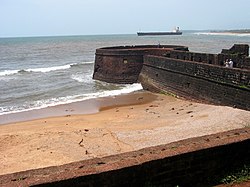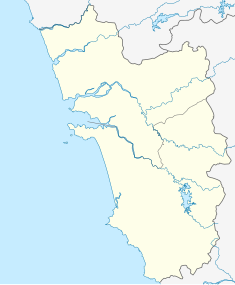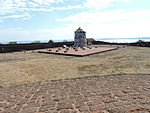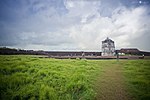
Raj Bhavan is a residential palace and fort situated in Dona Paula, Goa which serves as the official residence of the governor of Goa. The sprawling 88 acres estate is located on a cape in the Goan capital, Panjim. Known by the name "Palácio do Cabo" until it gained official status as the residence of the governor of Goa, this palace is said to be built between the 16th and 17th century in the erstwhile Portuguese India. The fort is strategically positioned facing the Arabian sea opposite the well-preserved 17th century Forte Aguada.

The Mandovi, also known as the Mhadei, is a river described as the lifeline of the Indian state of Goa. The Mandovi and the Zuari are the two principal rivers in the state of Goa. Mandovi joins with the Zuari at a common creek at Cabo Aguada, forming the Mormugao harbour. Panaji, the state capital and Old Goa, the former capital of Goa, are both situated on the left bank of the Mandovi.
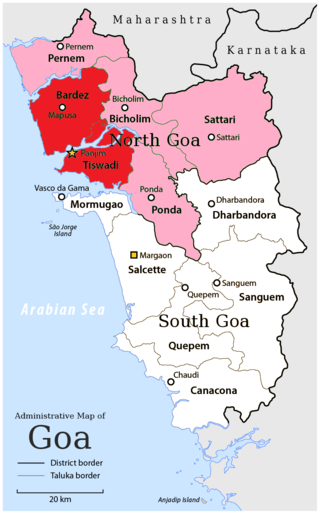
North Goa district is one of the two districts that constitutes the state of Goa, India. The district has an area of 1,736 square kilometres, and is bounded by Kolhapur and Sindhudurg districts of Maharashtra state to the north and by Belgavi district of Karnataka to the east, by South Goa district to the south, and by the Arabian Sea to the west.

Bardez is a taluka of the North Goa district in the Indian state of Goa.

Pernem is a northmost administrative region or sub-district in North Goa. It acts as the Gateway of Goa from Maharashtra side. It is also the name of the town of Pernem, which is its headquarters. It has a Municipal Council. Geographically, Pernem is surrounded by Sawantwadi sub-district on East, Arabian Sea on West, Bardez and Bicholim sub-district on south and Sawantwadi sub-district on north. The two rivers which decide the boundary of this sub-district are Terekhol River and Chapora River. Terekhol river acts as a border of Maharashtra and Goa while Chapora river acts as a border of Pernem sub-district and Bardez sub-district.
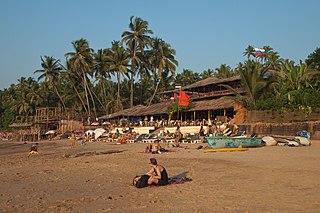
Anjuna is a village located on the coast of North Goa, India. It is a Census Town, one of the twelve Brahmin comunidades of Bardez. It is mostly a tourist destination.
Taj Hotels is a chain of luxury hotels and a subsidiary of the Indian Hotels Company Limited, headquartered in Mumbai, India. Incorporated by Jamsetji Tata in 1902, the company is a part of the Tata Group. The company employed over 20,000 people in the year 2010. The company has been ranked as the World’s Strongest Hotel Brand in 2022 and India’s Strongest Brand as per Brand Finance Hotels 50 Report 2022 and India 100 Report 2020, 2022 and 2023.
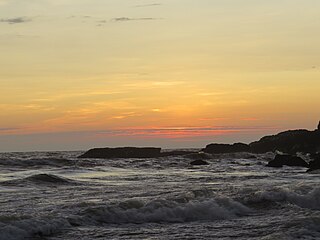
Calangute is a town in the North Goa district of the Indian state of Goa. It is famous for its beach, the largest in North Goa and a popular tourist destination. The peak tourist season is during Christmas and New Year, and during the summer in May. During the monsoon season, from June through September, the sea can be rough and swimming is prohibited. The beach offers water sport activities like parasailing and water skiing, among others.
Candolim is a census town in North Goa and is located in the Bardez taluka in the state of Goa, India. It is situated just south of Calangute Beach and North of Sinquerim.

Reis Magos is a village located on the northern bank of the Mandovi River in Bardez, Goa, opposite to the capital city of Panjim. The village is famous for two of Goa’s famous structures; the Reis Magos Fort, and the Reis Magos Church – the first church in Bardez. Reis Magos is the Portuguese name for the Three Wise Men from the Bible.

Tiswadi, formerly known as Ilhas, is a taluka in the district of North Goa, situated in the Indian coastal state of Goa. It is an estuarine island situated on the confluence of the Mandovi and Zuari rivers. It was one of the first territories to be annexed by Portugal in the sixteenth century. Both the state capital Panaji, and the erstwhile capital Old Goa lie within the subdistrict. It is the biggest and most populated of the six major islands between the Mandovi and Zuari rivers.

Baga a seaside town in Bardez, Goa, India. It comes under the jurisdiction of Calangute, which is 2 km south. Baga is known for its popular beach and Baga Creek. It is visited by thousands of tourists annually.

The state of Goa, in India, is famous for its beaches and places of worship. Tourism is its primary industry, and is generally focused on the coastal areas of Goa, with decreased tourist activity inland.

The Annexation of Goa was the process in which the Republic of India annexed Estado da Índia, the then Portuguese Indian territories of Goa, Daman and Diu, starting with the armed action carried out by the Indian Armed Forces in December 1961. In India, this action is referred to as the "Liberation of Goa". In Portugal, it is referred to as the "Invasion of Goa". Jawaharlal Nehru had hoped that the popular movement in Goa and the pressure of world public opinion would force the Portuguese Goan authorities to grant it independence but since it did not have any effect, he decided to take it by force.
Purushottam Kesava Kakodkar was a prominent politician and social worker from Goa. He served as a Member of Parliament in both the Lok Sabha and Rajya Sabha.

Taj Fort Aguada Resort & Spa, formerly Fort Aguada Beach Resort, is built on the crescent of the beach at Sinquerim, in Goa, India. The hotel is part of the chain hotels of Taj Group of Hotels.
Fort Assunção or Corjuem Fort is a fortress situated 4 kilometres (2.5 mi) from the village of Aldona on the river island of Corjuem, Goa. It was a military fortress for the defense of Portuguese India. It is smaller than the other forts in Goa, but it gives a good view of the surrounding river and land. It is a protected monument under the Goa, Daman and Diu ancient monuments and archaeological sites and remains act.

Goa is a state on the southwestern coast of India within the Konkan region, geographically separated from the Deccan highlands by the Western Ghats. It is bound by the Indian states of Maharashtra to the north, and Karnataka to the east and south, with the Arabian Sea in the west. It is India's smallest state by area and fourth-smallest by population. Goa has the highest GDP per capita among all Indian states, two and a half times as high as the GDP per capita of the country as a whole. The Eleventh Finance Commission of India named Goa the best-placed state because of its infrastructure, and India's National Commission on Population rated it as having the best quality of life in India. It is the third-highest ranking among Indian states in the human development index.

Goa, Daman and Diu Liberation Day is observed on December 19 every year in Goa, India. The Goa Liberation Day is celebrated in commemoration of the Indian armed forces annexing Portuguese-ruled Goa. Also, India was completely free from European rule on this day.

Roque Santana Joao Fernandes was an Indian politician and freedom fighter from Goa. He was a member of the Goa, Daman and Diu Legislative Assembly from 1967 to 1977, representing the Cuncolim Assembly constituency. He is popularly known as the "Father of Goan Democracy" and was responsible for the introduction of democracy by objecting to the Lt. Governor’s nomination through his satyagraha. He was one of the prominent people that contributed to Goa's freedom struggle.
